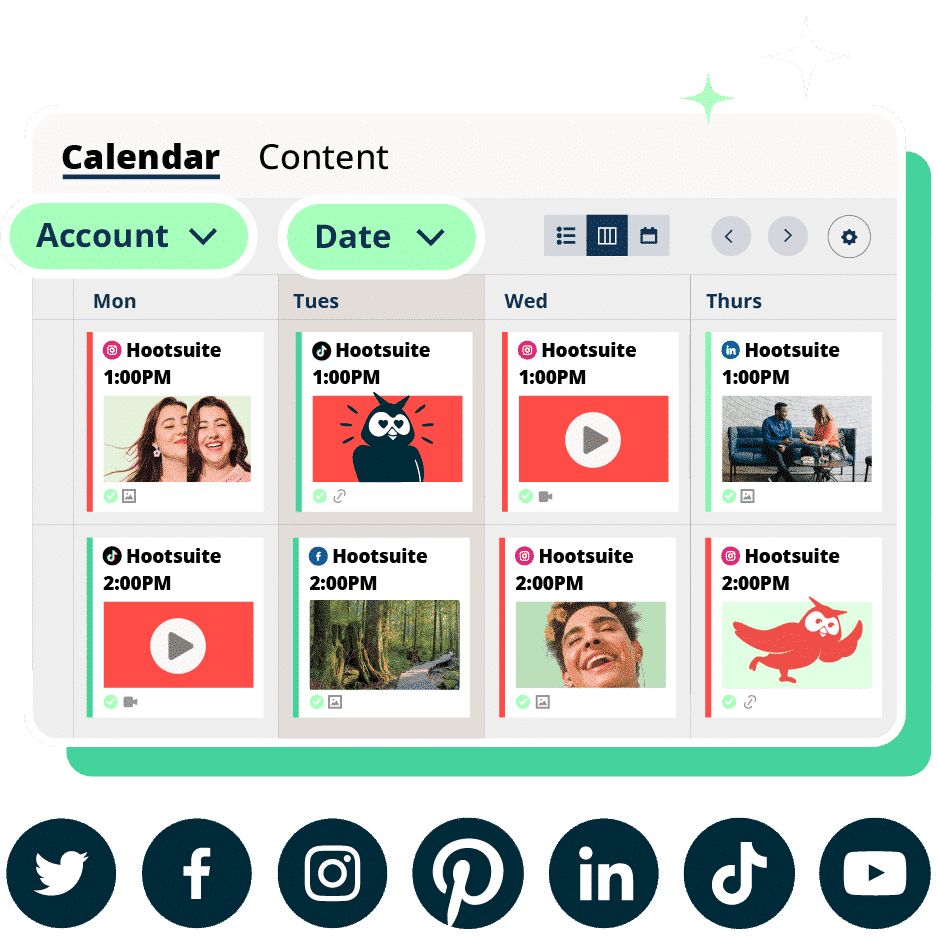Your LinkedIn profile could feature the most impressive resume in the world—wow, you led the marketing team at Clowns Monthly magazine and started a juggling training academy?—but if no one ever sees it, what’s the point?
That’s why LinkedIn SEO is a pivotal skill to hone. With more than a billion members on the career-focused social networking site, you’ve got to put in a little extra hustle to stand out from the crowd.
Whether you’re hoping to be discovered by a prospective employer (is that Ringling Bros in your DMs?!), future clients or potential employees, boosting your reach with these LinkedIn SEO secrets is a CEO-level move.
What is LinkedIn SEO?
LinkedIn SEO is the process of optimizing your LinkedIn page, posts and profile to increase your visibility in both LinkedIn and external search engine results.
SEO, or search engine optimization, is a standard practice in digital marketing — and it’s becoming increasingly common in social media. (Psstt: we talk about social SEO a lot, but that’s because it’s really important!) Google and Bing ads can also play a role in your overall visibility strategy.
Search engines like Google and Bing use their super-smart algorithms to match people searching for information with the content that matches their needs. And while social platforms aren’t technically search engines, they’re trying to do the exact same thing.
How do you make sure your next cool job opportunity, qualified applicant, or high-intent prospect finds you? It definitely doesn’t happen by accident — it’s all about strong LinkedIn SEO.
To optimize your LinkedIn discoverability, you’ll want to fine-tune the elements of your profile and use strong keywords wherever you can. More on that below.
Why is LinkedIn SEO so important?
LinkedIn SEO isn’t just about helping your content show up in the search results — it’s making sure the right people find you.
By choosing the right keywords and optimizing your content to reflect them (e.g. by including them in titles) you can make it more likely that people searching for those keywords land on your page. For LinkedIn SEO, it’s about using keywords that clearly communicate what a profile, a company page, or your posts are about.
If your organization specializes in social media marketing, for example, you’ll want to use keywords that match your industry, like “social media consultant,” “social media marketing services,” and “social media management.” (Good news! Our free LinkedIn post generator makes it easy.)
Because there are so many companies on LinkedIn competing for attention from the same customer base, LinkedIn SEO can make a huge difference. Either your competitors will show up first in search results or you will.
LinkedIn SEO ranking factors
Getting to the top of LinkedIn’s search results is easier when you understand LinkedIn’s algorithm. Knowledge! Is! Power!
According to the behind-the-scenes wizards at LinkedIn, every set of search results is personalized for whoever is searching. In that context, LinkedIn ranks profiles in search results based on a variety of factors:
- The LinkedIn member’s activity. Results will be tailored with consideration to the accounts you follow, activities you participate in, your connections and engagement.
- Public prominence. Are a lot of other people clicking on or engaging with your profile or Page? It’s more likely to show up in relevant search activity.
- Similarity to other searches by like-minded users. What have other LinkedIn users with similar search terms been engaging with? This gives the LinkedIn algorithm a good idea of what will be successful for other searches by similar users.
- Page name. Page names that match a keyword will appear in search results.
- Number of followers and connections. If a member has a lot of connections to other people who are connected to a Page, LinkedIn will serve this Page up high in the rankings.
- Volume and quality of engagement. Lots of quality discussion and reactions helps a Page obtain a higher ranking with LinkedIn.
Now that you have a bit of an idea as to why some LinkedIn profiles and pages rank above others, let’s go into how you can make it happen for yourself.
How to optimize your LinkedIn page or profile for SEO
The real trick to optimizing your LinkedIn profile for SEO starts with understanding not just what your job title or expertise is but also how other people are searching for LinkedIn users who do what you do.
What do prospects or recruiters type into the search bar when they’re looking for industry content? You can start by doing a little research using Google Keyword Planner, but poking around on LinkedIn itself is a good idea, too.
How do your peers classify themselves? What phrases are used consistently in your industry? What words does LinkedIn auto-suggest when you start typing in industry jargon into the search bar?
Once you’ve got your magic words assembled, it’s time to get to SEO-ing.
Use relevant keywords in your About or Description section
Those magic words you just pulled together? Professional SEOs call them keywords — and it’s time to put ‘em to work.
You’ve got 2,600 characters in this section, which means plenty of space to describe how your company sets itself apart from the competition, what makes your product a great option for potential customers, and how you got to where you are.
Write a few narrative paragraphs describing your work life (or, if you’re optimizing your LinkedIn Page for your company, your organization’s goals and missions) and make sure to incorporate as many keywords as is appropriate.

Try using variations on these words — not just “customer success” but “customer experience” and “customer service,” too — to capture any alternative search terms that might help the right people find you.
Upload high-quality images
Uploading high-quality images for your LinkedIn profile picture and your banner image helps the robots working behind the scenes know that your profile is serious and official.
You’ve put the time into completing all the different aspects of the profile; you’ve got to be the Real Deal, right? If you’re looking for a cheat sheet for LinkedIn image specs, we’ve got you covered.
Before you upload those photos, make sure you’ve given them a descriptive file name. Image names are a great way to incorporate some of those relevant keywords.
Craft a bold headline
Your LinkedIn headline (also known as a tagline) should, of course, be clear to the humans who visit your LinkedIn profile. Still, ensure that the ol’ LinkedIn search robots are clear about what you do, too.
Use every one of the 120 characters available to share the relevant details. Include your role title, your industry and your specialty to ensure you appear in search results for any of those keywords.

Tweak your experience section
Your experience section isn’t just an opportunity to show off the prestigious circus academy you attended. It’s also an avenue for increasing visibility on LinkedIn.
Share more than your job titles here: include what you did, which skills you showcased or developed, what major clients you worked with, and any impressive accomplishments.
The more you write about each job, the more keywords you’ll be able to seamlessly slide in.
Complete every section possible
Completion is the key to discoverability. The more keywords, the better.
And if you’re worried you’ve missed one, don’t fret. The platform will prompt you to complete anything you might have accidentally left blank.

Not only does the LinkedIn search engine like complete pages, but every section is a chance to add keywords that’ll help your page rank higher. Here are the fields you should absolutely complete in your page — and what you should put in them:
- Website: Make sure you include your company’s website in this field. It sounds like a no-brainer but hey, it’s easy to forget a field or two.
- Industry: Don’t forget to call out your industry here. It’ll make it easier for job seekers to find your company’s page.
- Specialties: This is a veritable treasure trove of SEO potential! You can include a ton of keywords here that tie your company page directly into high-value keywords people search for.
- Location: LinkedIn will automatically give you the right options for this when you put in your postal code, but you need to give this some thought. For example, if your company is headquartered around Toronto, you can either pick the exact city (e.g. Burlington) or the area (e.g. Greater Toronto Area). Depending on where you work, one option might be a stronger SEO choice than the other.
- Products: No matter what kind of product or service you sell, the Products tab is a great space to work some SEO magic. By adding a product, you get a whole paragraph to describe what it does and how it works. Even better, LinkedIn users will be prompted to add your product as a skill on their own profile, which can give you a ton more reach.

With these techniques, your LinkedIn page will show up at the top of search results, and you’ll get so many messages from potential connections it’ll start being its own problem.
Customize your LinkedIn URL
Did you know that you don’t have to keep your page’s original URL? LinkedIn will set a default URL for your page that’ll just be a bunch of numbers, sort of like this:
www.linkedin.com/in/company-x/69845325
If you want to improve your LinkedIn page’s SEO, you can edit your URL to reflect a keyword that ties into your industry. If you specialized in social media marketing, for example, you can customize your link like this:
www.linkedin.com/company-x-social-media-marketing
If your company is already well known in your niche, only including your name in the URL is also a good idea:

Plan content that fits with your keyword (and post at right time)
Your posts are another chance to include keywords and relevant search terms on your LinkedIn page. They’re also an opportunity to show off just how much you know about SaAS sales or unicycle leadership or whatever.

Our studies suggest that one or two times a day is the ideal frequency to post on LinkedIn, but your mileage may vary.
Hootsuite’s Best Time to Publish feature (found under Analytics) tells you the best times to post on LinkedIn (as well as Facebook, Instagram, Twitter and TikTok). The recommendations are based on your past performance and tailored to your unique audience and their activity patterns on social.
But, there’s no “best” time to publish for everything. The Best Time to Publish tool goes one step further than the rest and breaks down different suggested times for three key goals:
- Build awareness
- Increase engagement
- Drive traffic
This allows you to match each piece of content to a specific business goals and optimize your posting schedule for maximum effectiveness.

And don’t forget to post that top-tier thought leadership content when your followers are online and ready to read.
Hootsuite’s best time to post LinkedIn scheduling tool will make sure your brilliant ideas land in the newsfeed when it matters most.
Find more tips to get your LinkedIn content discovered here.
Get engaged with other accounts
Being an active, engaged member of the LinkedIn community is a surefire way to please the algorithm. As you’ll see below, LinkedIn takes member behavior into account when it ranks profiles in the search results.
Comment and react to other people’s posts, join the conversation in your own comment section, share posts that inspire you, and LinkedIn will learn that you’re a power player more people should know about.
Free LinkedIn SEO tool
Use this free social SEO tool to generate posts optimized for better visibility in LinkedIn search results.
Please note: This tool may display inaccurate or offensive material that doesn’t represent Hootsuite’s views. You’re solely responsible for use of any content generated using this tool, including its compliance with applicable laws and third party rights.
LinkedIn SEO FAQs
Does SEO matter on LinkedIn?
Oh, yes. Yes, yes, yes. Optimizing your profile or page for search on LinkedIn through LinkedIn SEO is the key to getting discovered. The LinkedIn algorithm has one billion profiles to sort through (and approximately nine trillion “Why failure is actually the key to success” posts), so making your identity and your intentions crystal clear through search engine optimization is key to winding up at the top of those search results.
Craft a strong headline and about section. Post relevant, keyword-packed content to your page consistently. Take the time to complete every section of your profile, adding in keywords as often as is appropriate. Basically, take every opportunity to communicate specifically what you’re all about. A little optimization goes a long way.
How do I optimize my LinkedIn Page for SEO?
Optimizing your LinkedIn Page for SEO starts with understanding what your best search terms are.
What words or phrases would someone looking for your particular set of skills and expertise use? (Eg: “communications and marketing” or “eel breeding.”) Are there any alternative phrases that might be helpful to work in there too? (Eg: “social media strategy” or “sea creature mating.”)
Once you’re clear on what LinkedIn keywords you’re trying to optimize, it’s time to spruce up that profile:
- Use relevant keywords in your About section
- Use keywords in your Headline
- Use keywords in your Experience section
- Complete as many of your LinkedIn profile sections as possible
- Customize your LinkedIn profile URL with your keywords
- Plan content for LinkedIn that includes your keyword (and post it at the right time for maximum engagement, of course)
- Post frequently
- Listen to LinkedIn when it suggests you do something
Easily manage your LinkedIn Page and all your other social channels using Hootsuite. Schedule and share content (including video), reply to comments, and engage your network — all from one simple dashboard. Try it free today.
With files from Nicholas Bouchard.








